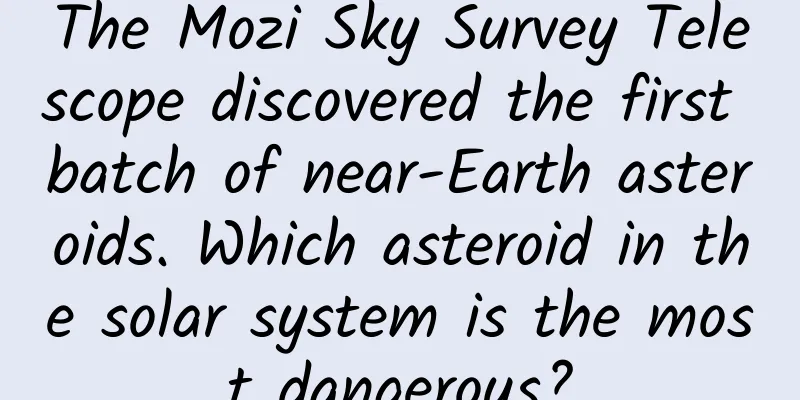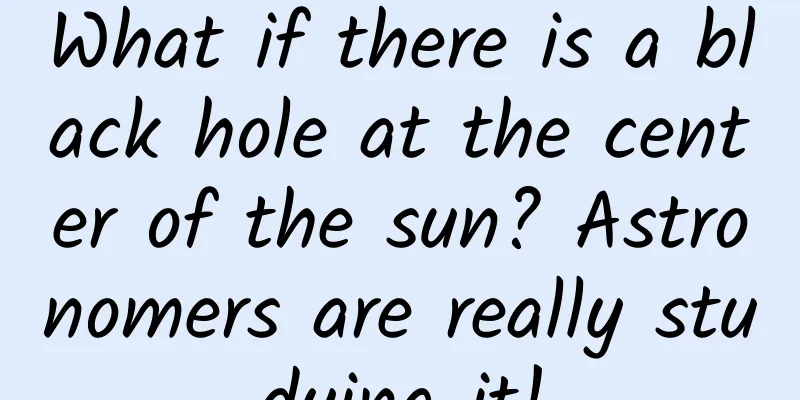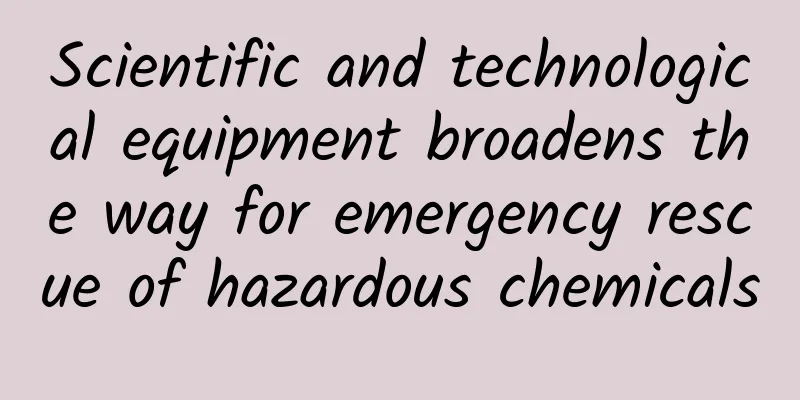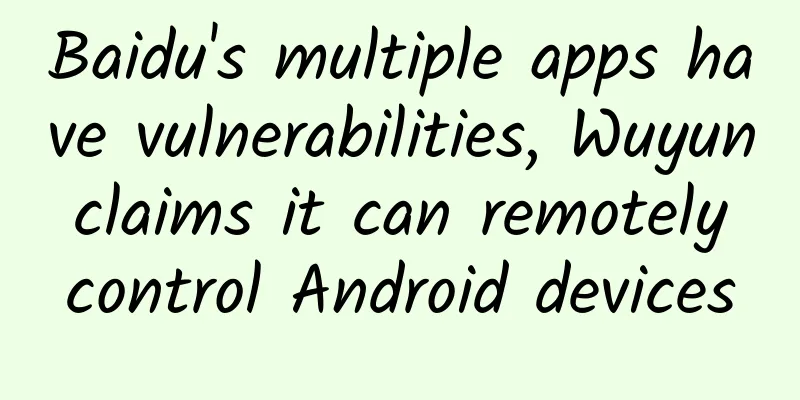The Mozi Sky Survey Telescope discovered the first batch of near-Earth asteroids. Which asteroid in the solar system is the most dangerous?

|
Author: Li Mingtao, Researcher at the National Space Science Center of the Chinese Academy of Sciences The International Astronomical Center recently (November 22, 2023) announced that the Mozi Survey Telescope has discovered two new near-Earth asteroids. These are the first near-Earth asteroids discovered by the Mozi Survey Telescope. What is worth noting about this discovery? First, let's talk about the Mozi Survey Telescope, which is a large-field optical telescope jointly developed by the University of Science and Technology of China and the Purple Mountain Observatory of the Chinese Academy of Sciences. It has an aperture of up to 2.5 meters and is currently the world's most powerful optical time-domain survey equipment. The Mozi Telescope released its first light image on September 17 this year (2023). The discovery of a near-Earth asteroid this time marks a key progress in the commissioning and operation of the Mozi Telescope, and also lays a solid foundation for the subsequent commercial search and monitoring of near-Earth asteroids. Then, let's talk about why scientists are so interested in asteroids. Asteroids are fragments left over from the early formation of the solar system 4.6 billion years ago, and are called time capsules of the solar system. Exploring asteroids can provide clues to major scientific issues such as the formation and early evolution of the solar system. Therefore, asteroid exploration is one of the hot spots of deep space exploration in the world. Spaceflight countries such as the United States and Japan have implemented asteroid exploration programs. Asteroids also contain valuable mineral resources, such as water, organic matter, iron, nickel and even precious metals such as platinum. The United States launched a probe in 2023 to conduct a close-range exploration of "Psyche" in the asteroid belt. "Psyche" is an almost all-metal asteroid with a diameter of more than 200 kilometers. It is estimated that the metal value of "Psyche" is as high as 100 billion US dollars, which is equivalent to about 10 billion yuan for every person on Earth. Therefore, space mining is also one of the development directions of commercial aerospace. Of course, asteroids can also bring disasters. Near-Earth asteroids will enter the vicinity of Earth's orbit, posing the risk of hitting the Earth. The scientific community generally believes that 66 million years ago, an asteroid with a diameter of about 10 kilometers hit the Gulf of Mexico in North America, changing the Earth's climate and environment, leading to the extinction of 75% of the world's species, including dinosaurs. Scientists are very interested in asteroids because of their great scientific research value, resource development value, and significant threat to life on Earth. One of the main scientific goals of the Mozi telescope is to search for and discover near-Earth asteroids in the solar system, and to provide support for planetary science research, resource development and utilization, and asteroid defense. Among the two asteroids discovered this time, one is a near-Earth asteroid that poses a potential threat to the Earth. But don't worry, after calculation and analysis, this asteroid poses no threat to the Earth within a predictable time scale. I believe that in the future, the Mozi telescope will continue to make more scientific discoveries and bring us greater surprises. At this point, you must want to know which asteroid in the solar system is the most dangerous. NASA has ranked the danger levels of near-Earth asteroids based on factors such as the possibility of an asteroid hitting the Earth and the scale of harm caused by the impact. Among the asteroids that have been discovered so far, the Bennu asteroid poses the greatest threat to humans. When it approaches the Earth on September 24, 2182, the probability of it hitting the Earth is 0.037%. The Bennu asteroid is about 490 meters in diameter. Once it hits the Earth, it may cause an intercontinental disaster and kill millions of people. However, 2182 is still more than 150 years away from us. I believe that humans will be able to safely dispose of the Bennu asteroid by then. It is worth mentioning that the Bennu asteroid is also the target asteroid of the US OSIRIS-REx asteroid probe. The probe has brought back the return capsule carrying samples of the Bennu asteroid to Earth in September 2023, and the probe will continue to fly to the famous Apophis asteroid and be renamed OSIRIS-APEX to conduct exploration of the Apophis asteroid when it arrives on Earth in 2029. Preliminary analysis shows that the samples of the Bennu asteroid contain water and organic matter. Some scientists believe that the water on Earth may have been brought by the impact of an asteroid or comet. Perhaps through the study of the samples of the Bennu asteroid, scientists will provide key clues to reveal the origin of water on Earth. Near-Earth asteroids are also one of the key targets of China's space program. China's "Tianwen-2" asteroid exploration program has been approved and is expected to be launched in 2025. It will complete the sampling and return of the near-Earth asteroid 2016 HO3 and the flyby exploration of the main-belt comet 311P. What is even more exciting is that since 2020, the China National Space Administration has organized and carried out the demonstration of my country's medium- and long-term development plan for asteroid defense and China's first on-orbit verification mission plan for asteroid defense. It is planned to complete my country's first on-orbit verification of asteroid defense by 2030, and conduct close-in exploration and impact defense tests on an asteroid with a diameter of about 30 meters. This will be the second time that humans have carried out an impact defense test on a near-Earth asteroid after the United States' "Double Asteroid Redirection Test (DART)" mission, and it will also be the first time that humans have directly changed the orbit of a near-Earth asteroid relative to the sun. I believe that in the future, China's space program will definitely make a difference in the field of asteroids and contribute more Chinese wisdom, Chinese solutions and Chinese strength to protecting the Earth's home and building a community with a shared future for mankind. This article is a work supported by Science Popularization China Starry Sky Project Author: Li Mingtao Reviewer: Gou Lijun, researcher at the National Astronomical Observatory of the Chinese Academy of Sciences Produced by: China Association for Science and Technology Department of Science Popularization Producer: China Science and Technology Press Co., Ltd., Beijing Zhongke Xinghe Culture Media Co., Ltd. |
<<: The lightning killer cheetah turns out to be a big cowardly cat!
Recommend
How much does it cost to develop a Daqing business mini program? What is the quotation for the development of Daqing Business Mini Program?
There are two types of Daqing Commerce WeChat Min...
How to make https certificate and HTTPS?
1. Why must we upgrade to HTTPS? The HTTP protoco...
Big Fish Chinese Studies - Three Character Classic Enlightenment Lecture Baidu Cloud Download
Big Fish Chinese Studies - Three Character Classi...
How to build a good community using content, users, and activities? (Attached with case)
The article combines the author's actual expe...
Try the Xiaozhi Butler Robot. Is it time to hire an intelligent assistant?
In addition to fear, AlphaGo's victory should...
A review of the top 11 marketing cases in 2019
November is over, and there is not much left in 2...
The longest train in China runs every 12 minutes on average.
Have you seen the longest train in China? Count t...
Implementing source code coverage for Swift step by step
introduce Recently, I have been researching solut...
How to become an operations expert? Here is a structural diagram for you!
Now that we have to build a standard operation st...
How to arouse users’ interest in 15 seconds?
Suppose your company is holding a food tasting ev...
Xigua, Huoshan, and Douyin data: daily activity, retention, and average daily usage times and duration
Everyone knows that the Internet short video fiel...
Knowledge payment, the logic of hot selling
1. Knowledge Entrepreneurship was Hot Recently, a...
Qoros Auto seeks to make a comeback, launching 26 new models in 5 years, investing 10 billion yuan a year
Recently, Qoros Auto announced an ambitious five-...
From environment setup to memory analysis: A guide to Python code optimization
Code address: https://github.com/apatrascu/huntin...
Helping the color TV industry build a "new ecology" and becoming an international TV brand, Mango TV
When traditional industries are linked to the Int...









